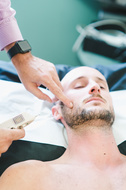
"If you can't explain it simply, you don't understand it well enough."
-Albert Einstein
I think it's just human nature to have to complicate things. But when you're in the clinic, that is no time to be an academic or philosopher.
I've always harped on clinical results. Working in the clinic is working in the trenches so to speak. This is where the rubber meets the road. Any flowery ideas of acupuncture or Chinese medicine, all the lovely beautiful concepts and theories, they mean nothing. Results are the only thing that matters - and the treatments behind them. While many think this disparages the "art", what it actually is, is putting the patient first. I will never apologize for putting the patient above ideology that doesn't deliver results, and only serves to comfort one's ego.
I've seen so many peeps brag about what they can do. What they know, how they can "control qi", or the degrees they have. Something is always missing in this bragging though - the patient.
Learning is fun, philosophy is extremely interesting, exploring new idea is important. But in the clinic it's all about keeping it simple.
Likewise, how are you explaining things to your patients? Are you lecturing on the differences between acupuncture and dry needling? Are you over explaining how your treatments are helping them? Have you noticed they glaze over after about 30 seconds?
It's best to keep working on your scripts and saying things very direct. Give the patients what they need - results. We excel in the clinic, delivering the tools we've learned. If we're talking, we're not working (unless you can do both at the same time).
And please, keep it simple!
January’s webinar is here! This one is a favorite of mine because it includes the fascial lens when teaching the movement of the foot and ankle. It cover anatomy, fascia, and accessory motion of the foot and ankle. Definitely worth checking out.
Give this a read after you watch the video: https://pmc.ncbi.nlm.nih.gov/articles/PMC7689775/
Athletic Intensive Myofascial Release
Location: Shokunin CrossFit, Mesa, AZ
Pre-requisite: EXSTORE
Register here:
https://aseseminars.com/event/athletic-intensive-myofascial-seminar/
Hi there,
Is there a webinar on your site that you recommend for determining an algorithim of care so that the body responds most optimally? I work with patients who have hurt themselves on the job, so i am managing them for at least 5-6 weeks for pain or injury from their job. i.e. pain managment and decreasing inflammation (first session), motor point or trigger point, myofacial release, strenthening the muscle, posture? I work closely with a Chiropractor and PT person so we integrate all of our modalities.
We are adding a live lab after Anthony’s Intro to Exstore webinar! The webinar starts at 8:30pm EST and around 9pm EST lab will start. I hope to see you there!
Register Here: https://us02web.zoom.us/meeting/register/LJkJLHkcQi2HjplSqxb5Pg















